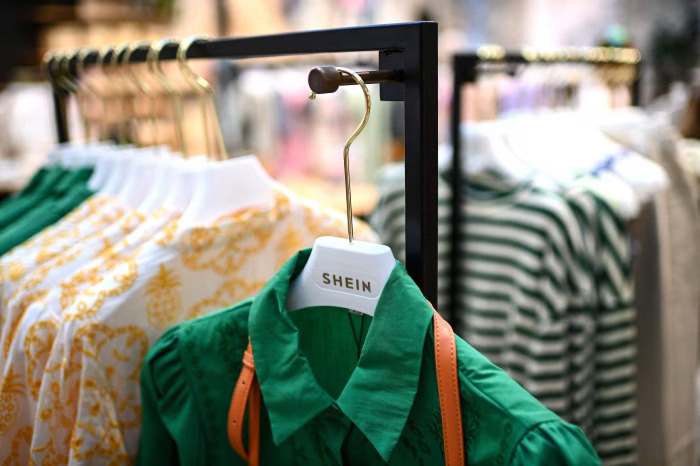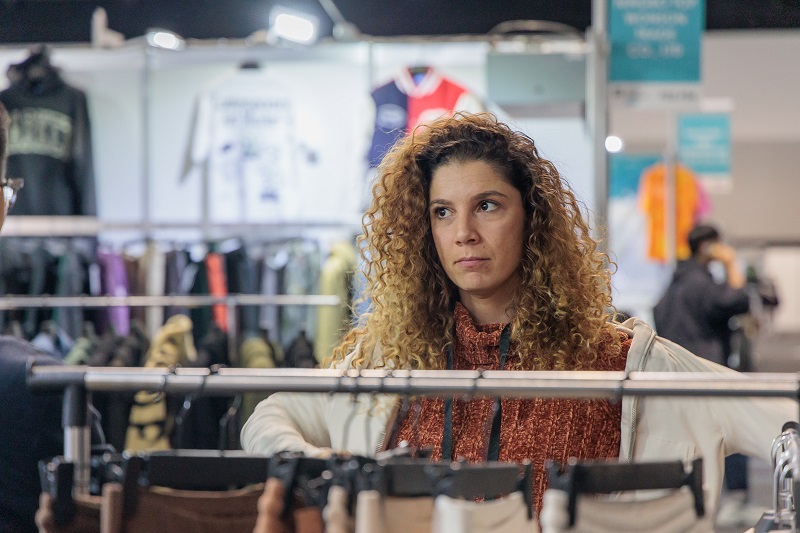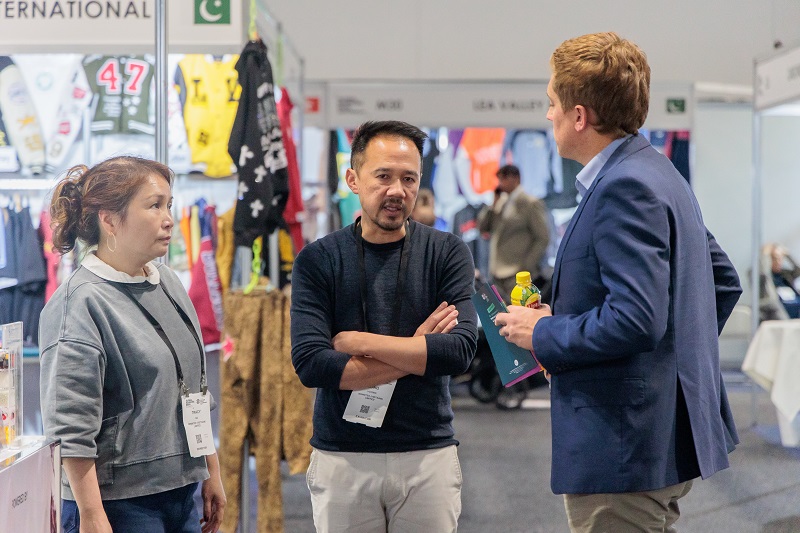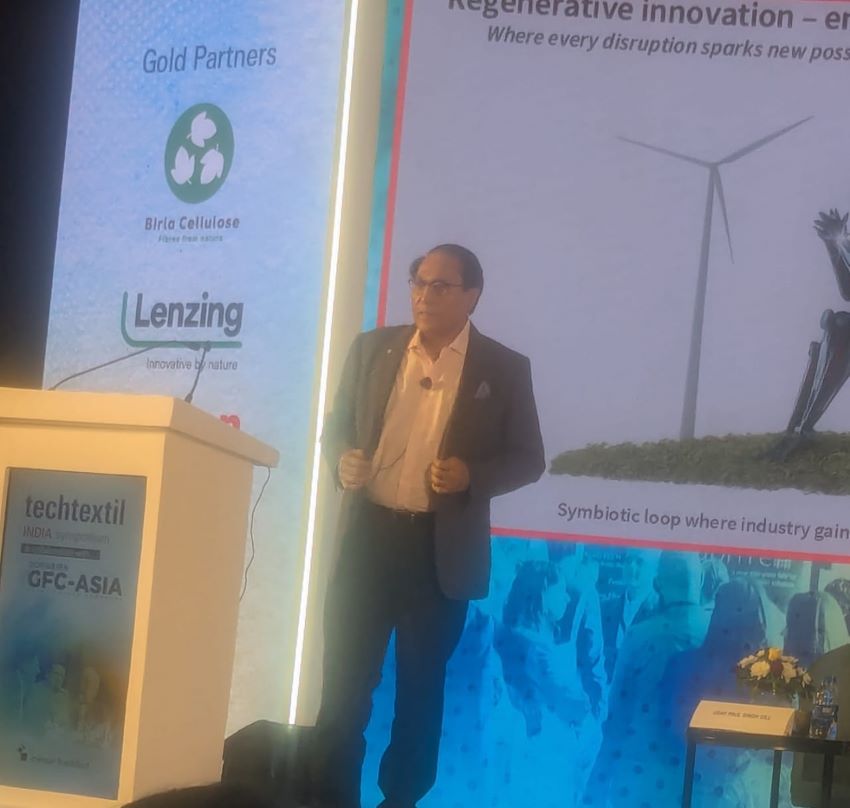FW
Upcoming Free Trade Agreements (FTAs) with the United States, the United Kingdom, and the European Union are expected to unlock significant growth opportunities for India's textile sector with exports rising to $100 billion by 2030 from the current $34 billion, said Pabitra Margherita, Union Minister of State for Textiles at the 73rd India International Garment Fair (IIGF) at Yashobhoomi.
Margherita underscored the strategic importance of these FTAs, stating that negotiations with the EU and the US, along with the India-UK FTA, will open new avenues for growth. She emphasized, these are ‘high-value, quality-conscious markets,’ and India is committed to equipping its exporters with the necessary strategies, standards, and compliance to capitalize on these opportunities.
The textile and apparel industry plays a crucial role in the Indian economy, contributing 2.3 per cent to the GDP, 13 per cent to industrial output, and 12 per cent to national exports. In FY23-24, India's textile exports reached $34.4 billion, with apparel accounting for a significant 42 per cent of that total. Margherita emphasized, achieving the $100 billion export target by 2030 will require the active participation of every MSME, entrepreneur, and exporter.
The ongoing three-day IIGF, organized by the Apparel Export Promotion Council (AEPC), features over 360 exhibitors from across India and buyers from 80 countries. Margherita lauded the event as Asia's largest garment fair, showcasing India's rich creativity and craftsmanship. Buyers from diverse regions including North America, Europe, Asia, and Africa are attending.
Given that over 80 per cent of India's textile sector is driven by MSMEs, Margherita emphasized on the need to boost productivity, ensure consistent raw material supply, and minimize import dependency to maintain global competitiveness. Sudhir Sekhri, Chairman, AEPC added, the fair serves as a vital platform for promoting 'Made in India' fashion globally. He projected India's garment exports to reach $40 billion by 2030, noting a commendable 12.8 per cent cumulative growth in apparel exports during the first two months of FY2025-26, despite global challenges
H&M is expanding its exploration of generative AI by releasing its first series of images featuring digital twins. Set against the backdrop of global fashion capitals, these images showcase seasonal denim that also embodies a timeless appeal.
Co-created with a dedicated team and complemented by a behind-the-scenes film, H&M aims to demonstrate how generative AI can amplify creative processes and elevate fashion storytelling.
The brand is exploring emerging technologies like generative AI to amplify creativity and reimagine how it showcases fashion, says Jörgen Andersson, CEO, H&M. The technology offers the brand an opportunity to enhance storytelling and find new ways to connect with their customers, while staying true to H&M’s style-led, human-centric identity. The brand remains committed to empowering self-expression and liberate fashion for the many."
This initial launch went live on July 2, and H&M plans to continue its exploration throughout the fall with various expressions across different cities.
UK's premier marketplace for home, gift, and fashion, Autumn Fair 2025 has unveiled its most ambitious and retailer-focused content program yet. Designed with the needs of independent retailers in mind, this practical and easy-to-consume agenda aims to deliver maximum value efficiently, allowing buyers to prioritize their sourcing.
Being held at the NEC Birmingham from September 7-10, 2025, this year's event directly addresses the challenges faced by independent retailers, including rising costs, evolving customer behaviors, and the demands of digital transformation. The response is a powerful new program featuring over 30 short, high-impact sessions.
Presented across the new Retail Corner stage and Buyers Retreat, the agenda is packed with real-world strategies, future-facing trend intelligence, and expert-led workshops. These sessions are tailored to help home, gift, and fashion retailers buy smarter, sell better, and future-proof their businesses, all while staying connected to the broader retail industry.
The content focuses on profit-driving insight, trend intelligence, and practical transformation, curated specifically for the realities of independent retail. Topics range from social commerce and sustainability to licensing, merchandising, and consumer psychology, offering a holistic view of the retail landscape and how to stay ahead. The organizers describe this year's lineup as a masterclass in next-generation retail.
Soraya Gadelrab, Event Director, Autumn Fair, emphasizes, Autumn Fair 2025 introduces a powerful new content agenda that’s practical, focused, and easy to consume, designed to fit around your buying and deliver maximum value in minimal time. This is about giving you real-world strategies and actionable insights that can make a genuine difference to your business, she adds.
Leading global fashion and lifestyle retail conglomerate, Apparel Group has officially launched its Summer 2025 campaign, titled, ‘Your Style, Your Story.’ This bold and emotionally resonant initiative celebrates individuality, creativity, and seasonal innovation across all generations.
Thoughtfully designed to connect with every age group, from grandparents to Gen Z and children, the campaign showcases a curated portfolio of iconic brands that cater to diverse styles, lifestyles, and life stages. Whether customers are seeking performance-driven pieces from F5 Global, casual essentials from R&B, comfort-first footwear from Skechers, or the timeless sophistication of Tommy Hilfiger, the Summer 2025 Catalogue promises something unique for everyone.
The heart of the campaign is its Summer 2025 Catalogue, which is being featured across digital platforms, including 6thStreet.com, and within flagship stores. A collection of products; the Catalogue blends editorial-inspired visuals, immersive style edits, and modern-day essentials, reflecting the evolving identity of today's shopper through a seamless mix of inspiration, curation, and accessibility.
Neeraj Teckchandani, CEO, Apparel Group, states, more than just a seasonal launch, the campaign is a strategic reflection of how consumers use fashion to express identity. It offers a retail experience that feels personal, curated, and connected, while celebrating the rich diversity of style across the region.
Based in Dubai, UAE, the Apparel Group boasts a growing network of over 2,300 stores and a diverse portfolio of over 85 international brands across 14 countries, including a strong presence in the GCC, India, Southeast Asia, South Africa, and Egypt. Led by Sima Ganwani Ved and Nilesh Ved, Founders, the Group represents global names like Tommy Hilfiger, Skechers, ALDO, Charles & Keith, and Tim Hortons, driven by a multicultural workforce of over 27,000.
Gartex Texprocess India is launching the ‘Textile Care Forum’ in partnership with the Drycleaners and Launderers Association of India (DLAI)
Set to debut at the upcoming Gartex Texprocess India exhibition from August 21-23, 2025, in New Delhi, this strategic collaboration reflects the evolving landscape of India's textile care industry. DLAI will serve as the Knowledge Partner for the forum, scheduled for August 22, aiming to foster networking and innovation within the sector.
India's laundry and textile care segment is experiencing significant growth, driven by an increasing emphasis on eco-friendly chemicals, waterless cleaning systems, and sustainable operations. Valued at $1.31 billion in 2024, the Indian dry-cleaning services market is projected to reach $2.09 billion by 2033, demonstrating a robust 5.40 CAGR. This partnership strengthens Gartex Texprocess India's offerings by integrating the global expertise of Messe Frankfurt Group's renowned 'Texcare' brand, a leading reference point for the laundry and textile services industry worldwide.
Connecting over 3,000 stakeholders from traditional launderers to commercial laundry chains, DLAI will enhance the forum's focus on professional cleaning as an integral part of the garment and textile ecosystem. The Textile Care Forum will spotlight innovations in cleaning machinery, stain treatment solutions, biodegradable chemicals, and automation, encouraging broader participation from the segment.
Raj Manek, Executive Director & Board Member, Messe Frankfurt Asia Holdings notes, the partnership aligns Texcare's global vision with Gartex Texprocess India.
The forum will enhance the show's offerings and bring a sharper focus to sustainability and hygiene, adds Himani Gulati, Director, MEX Exhibitions,
This alliance will enable DLAI to bring sector-specific insights, experts, workshops, and curated pavilions to the event, promoting industry upskilling and future readiness. Gartex Texprocess India is thus expanding its scope to become a comprehensive hub for India’s textile machinery, denim, screen printing, fabrics, trims, accessories, and now, the vital textile care ecosystem.
Launched at the June Global Fashion Summit: Copenhagen Edition 2025, the Fashion Impact Toolkit is set to become a vital resource for textile companies navigating complex sustainability challenges. This interactive tool offers an impact inventory and a comprehensive framework designed for businesses throughout the entire textile value chain. This includes raw material producers, retailers, recyclers, and remanufacturers, and it's applicable across major sub-sectors like high-street fashion, luxury, footwear, sportswear, and textile manufacturing. It serves as an initial step for companies to map their areas of influence based on factors such as materials, processes, and geographies.
The Fashion Impact Toolkit will be a valuable resource for the textile industry as it navigates increasing regulatory and stakeholder pressure, states Federica Marchionni, CEO, Global Fashion Agenda. By identifying and addressing the most critical sustainability implications across the value chain, companies can foster greater resilience, build trust, and achieve long-term transformation, she adds.
The Toolkit details nearly 3,000 potential impacts, encompassing both challenges and opportunities, to aid leaders in their decision-making. Its foundation involves geographical scoping to pinpoint potential impacts across the main stages of the textile lifecycle. This results in a value chain mapping and impact inventory that highlight key hotspots and pressure points across six distinct stages: production of materials, garment manufacturing, product distribution and use, end-of-life management, material recycling, and high-value recovery activities.
Structured according to the European Financial Reporting Advisory Group’s (EFRAG) European Sustainability Reporting Standards (ESRS), the interactive Toolkit guides organizations through a seven-step framework. This includes identifying their position in the value chain, generating material- and geography-specific insights, translating sector-wide impacts to company-specific ones, quantifying identified potential impacts, defining risks and opportunities, shaping ambition and strategy, and collaborating for systemic change.
A prominent Indian apparel manufacturer, Active Clothing Co has entered into a landmark agreement with a China-based global leader in computerized flat knitting machines, Ningbo Cixing Co to launch India's first ‘Knit To Shape’ Smart Knitting Factory, marking a significant leap forward in the nation's textile innovation.
This futuristic facility aims to revolutionize sweater and knitwear manufacturing in India by integrating cutting-edge technologies. Key features of the ‘Knit To Shape’ factory include advanced 3D seamless knitting, which allows for enhanced design flexibility and garment durability, eliminating the need for traditional cutting and sewing. The factory will also incorporate automation driven by artificial intelligence and precision engineering, leading to high-precision, productivity-boosting production lines.
A core focus of this initiative is sustainability, with a commitment to zero-waste manufacturing processes. By utilizing Cixing's state-of-the-art flat knitting equipment and intelligent design systems, Active Clothing Co will be able to produce high-quality knitwear with minimal material wastage, aligning with global environmental objectives.
Rajesh Kumar Mehra, Managing Director , Active Clothing Co, emphasizes, this collaboration signifies a major milestone for both Active Clothing and the broader Indian apparel industry. The ‘Knit to Shape’ factory represents a shift towards intelligent, sustainable, and future-ready manufacturing, bringing advanced knitting technology to India to reduce waste and enhance design precision, he adds.
The establishment of this smart factory is expected to generate employment, foster skill development, and accelerate India's transition into a global smart garment manufacturing hub. This initiative aligns seamlessly with the Indian government's ‘Make in India’ and sustainability visions, positioning Active Clothing as a trailblazer in smart manufacturing for both domestic and export markets, promising flexibility, faster turnaround times, and sustainable operations.

Global fast-fashion behemoth Shein released its extensive 2024 Sustainability and Social Impact Report in June, a document exceeding 100 pages. The report comes amidst the company's recent incorporation of high-profile environmental initiatives, notably becoming a signatory to the UN Global Compact and an approved member of the Science Based Targets initiative (SBTi). Such affiliations typically signal a strong commitment to climate action and ethical conduct. However, a closer look at the report's underlying data, combined with Shein's operational realities, reveals a stark contrast that challenges the credibility of its sustainability narrative.
Growth amidst green pledges
The most striking revelation from Shein's report concerns its greenhouse gas (GHG) emissions. Despite its SBTi approval – an initiative designed to guide companies on ambitious emissions reductions aligned with climate science – Shein reported a 23 per cent growth in GHG emissions based on a restated prior year. Over the last three years, this growth escalates nearly 300 per cent. To put this into perspective, Shein's current emissions volume dwarfs that of its major competitors:
Shein vs. peers (approximate GHG emissions comparison)
o Shein: Nearly 2X Inditex (Zara)
o Shein: 3X H&M
o Shein: 2.5X Nike
The company's target to reduce Scope 3 emissions by 25 per cent by 2030, a cornerstone of its SBTi commitment, stretches credulity when juxtaposed against its current growth trajectory.
Analysts suggest that achieving this target, assuming continued company growth, would necessitate an implausible 85 per cent per-unit reduction in carbon intensity – a feat rarely seen in any industry, let alone a rapidly expanding fast-fashion model. Compounding this skepticism, Shein's own materiality matrix, a tool for identifying business risks and opportunities, classifies ‘Climate Change’ as financially immaterial to the company. This internal assessment appears to contradict the very essence of sustainability leadership it claims externally.
The air freight addiction
A major driver of Shein's colossal emissions footprint is its logistics strategy. The report highlights transportation emissions of 8.5 million tons of CO2. This figure alone is approximately 60 per cent higher than the total emissions of Adidas, a company with a global footprint and established supply chains. The root cause lies in Shein's heavy reliance on air shipment. Air transport is exponentially more carbon-intensive than sea freight, typically consuming 40 to 50 times more emissions per ton-mile. This reliance on rapid air delivery is intrinsically linked to Shein's 'instant fashion' model, which thrives on quick turnaround times from design to consumer, bypassing slower, less emissions-heavy shipping methods.
Synthetic saturation and distant circularity goals
The material composition of Shein's products further complicates its sustainability claims. Over 85 per cent of its garments are made from synthetics, primarily derived from fossil fuels. This heavy dependence on petroleum-based fabrics runs counter to principles of environmental stewardship and circularity.
While Shein publicly commits to "establish a fully circular textile supply chain by 2050" and achieve "NetZero by 2050," these commitments are decades away and lack interim, binding consequences. Critics argue the fundamental nature of 'instant fashion' – rapid production of low-cost, disposable garments – actively undermines the very concept of circularity. Such a model inevitably clogs collection points and overwhelms second-hand markets, creating an ever-increasing waste stream rather than a closed loop.
Audit findings and gaps in social impact
Beyond environmental concerns, Shein's report also touches on its social impact efforts, particularly factory audits. The company conducted over 4,000 audits, with a commendable 95 per cent carried out by third-party auditors. However, the outcomes reveal a concerning picture: 53 per cent of these audits resulted in grades of C or below, indicating significant non-compliance or areas for improvement. Despite these widespread deficiencies, only 12 factories were terminated. This suggests a lenient approach to addressing systemic issues within its supply chain, raising questions about the company's commitment to robust social standards and worker welfare.
Beyond the report
The issues highlighted within and implied by Shein's own report are just a fraction of the broader criticisms leveled against the company. Concerns persist regarding "dark patterns" in its e-commerce practices, allegations of intellectual property infringement, the sheer volume of waste generated by its 'instant fashion' model, and even the reported use of banned cotton.
In sum, while Shein's 2024 Sustainability and Social Impact Report aims to project an image of responsibility, a critical examination of its disclosed data and operational practices suggests a significant chasm between stated ambitions and current realities. The question remains: how believable are Shein's claims when its core business model appears to be fundamentally at odds with genuine sustainability and impactful social change?

The aisles of the Global Sourcing Expo Australia, which concluded its three-day run from June 17-19 in Sydney, buzzed with a clear message: Australia's approach to global sourcing is undergoing a profound transformation. As the nation's only dedicated exhibition for apparel, footwear, textiles, and homewares , the event served as a barometer for a landscape increasingly defined by diversification, resilience, and a heightened focus on ethical and sustainable practices.
The Imperative for Change: Beyond cost
Australia stands out globally for its high fashion consumption, with individuals purchasing an average of 56 items per year. However, this consumption comes with a significant environmental footprint, as approximately 22,000 tonnes of clothing waste are sent to landfills annually, with only 7% being recycled. This environmental challenge, coupled with a growing consumer demand for sustainable and ethically produced products, is a primary driver reshaping sourcing decisions.
Beyond sustainability, global trade disruptions, including geopolitical shifts and the lessons learned from the pandemic, have underscored the critical need for supply chain resilience. Businesses worldwide are actively pursuing "China Plus One" strategies to reduce over-reliance on single markets, seeking stable and diversified supply networks. This strategic imperative is fundamentally altering Australia's import landscape.

A Shifting Import Map: Data reveals diversification
Historically, Australia's textile and clothing imports (classified under HS codes 50-63) have been heavily concentrated. While China remains the dominant player, other nations are steadily increasing their presence. The following tables illustrate the changing landscape of Australia's textile and clothing imports from key partners over recent years:
Australia's Textile and Clothing Imports (HS 50-63) by Partner Country (US$ Thousand)
|
Country |
2019 |
2021 |
2022 |
|
China |
5,676,200.06 |
6,872,182.65 |
7,467,787.29 |
|
Bangladesh |
749,553.56 |
883,506.66 |
1,012,207.05 |
|
India |
514,495.17 |
693,173.18 |
788,223.65 |
|
Vietnam |
366,798.88 |
488,342.62 |
635,610.45 |
|
Indonesia |
257,765.14 |
300,340.45 |
319,930.29 |
|
Others |
2,054,153.21 |
N/A |
2,673,964.82 |
|
Total World |
9,619,166.95 |
N/A |
12,906,335.32 |
Source: WITS World Bank, UN Comtrade (as cited in snippets)
Share based on 2022 statistics
|
Country |
Trade Value (US$ Thousand) |
Share (%) |
|
China |
7,467,787.29 |
57.86 |
|
Bangladesh |
1,012,207.05 |
7.84 |
|
India |
788,223.65 |
6.11 |
|
Vietnam |
635,610.45 |
4.92 |
|
Indonesia |
319,930.29 |
2.48 |
|
Others (159 partners) |
2,673,964.82 |
20.72 |
Note: Comprehensive, publicly available annual data for Australia's total textile and clothing imports (HS 50-63) by specific partner country for years beyond 2022 was not available in the provided research material from primary sources like UN Comtrade or WITS World Bank.
Despite the limitations in granular data for the latest years, overall trends indicate continued shifts. Australia's apparel and clothing accessories imports (classified under code 84) increased by 14.68% to $1.148 billion in July 2024, the first month of the new fiscal year (July 2024-June 2025). In the fiscal year 2023-24, Australia's apparel imports totaled $12.231 billion, a slight decline of 5.2% from the previous fiscal year. Imports of textile yarn, fabrics, and made-up articles (classified under code 65) also saw a decrease of 9.40% in 2023-24, reaching $4.371 billion.
Free Trade Agreements (FTAs) are playing a crucial role in this shift. For instance, the India-Australia Economic Cooperation and Trade Agreement (ECTA), effective since December 29, 2022, has eliminated tariffs on nearly 96% of Indian textile and apparel exports to Australia (set to reach 100% by January 1, 2026). This provides a competitive edge for Indian products, contributing to the growth seen in the table. This growth is part of Australia's broader strategy to secure and diversify its supply chains.
New sourcing strategies and business models
Australian retailers are adapting their sourcing strategies to meet these evolving demands. The Global Sourcing Expo provided a platform for international suppliers to showcase their capabilities, emphasizing not just cost-effectiveness but also ethical production and innovative materials.
The rise of e-commerce is also profoundly impacting sourcing. Australia's clothing market is experiencing substantial growth driven by online shopping, with e-commerce accounting for 17.4% of the fashion and apparel sector. This digital dominance encourages global suppliers to develop robust online strategies, including direct-to-consumer (D2C) models, to reach a wider Australian consumer base.
The expo also highlighted a growing interest from Australian retailers in sustainable textiles and ethically sourced traditional Indian fabrics, including hand block prints, catering to a niche market that values authenticity and craftsmanship. This demonstrates a shift towards suppliers who can meet stringent environmental and social criteria.

Navigating challenges and seizing opportunities
Despite the clear opportunities, challenges remain. Intense competition from established manufacturing hubs like China, Bangladesh, and Vietnam continues to shape the market. Furthermore, logistical complexities, including high shipping costs and transit times, particularly from distant markets, require careful management. Adherence to Australia's specific quality standards, including chemical regulations and labeling requirements, is also paramount for all international suppliers.
However, the opportunities for diversification and growth are significant. The ongoing negotiations for comprehensive trade agreements, such as the Comprehensive Economic Cooperation Agreement (CECA) between Australia and India, signal a long-term commitment to deepening economic ties and further liberalizing trade across various sectors.
The Global Sourcing Expo underscored that Australia's sourcing landscape is no longer solely about finding the cheapest production. It's about building resilient, ethical, and diversified supply chains that can meet the demands of an increasingly conscious consumer base and a volatile global economy. The shift is global, strategic, and set to redefine how Australia dresses and furnishes its homes for years to come.

The recent cyberattack that brought down Marks & Spencer's (M&S) online operations for nearly seven weeks has highlighted a critical, often overlooked dimension of modern commerce: e-commerce's growing role as a weaponized competitive tool. While M&S grappled with a 20 per cent slump in clothing sales during the outage, rivals like Next, Zara, and H&M swiftly capitalized on the disruption, demonstrating how digital resilience and a robust online presence can be leveraged for significant market gains.
The incident at M&S, which saw its website – responsible for a third of its clothing and homeware sales – offline from April 25th to June 10th, highlights the vulnerability of businesses heavily reliant on their digital storefronts. This wasn't merely an inconvenience; it was a direct transfer of market share to competitors, underscoring e-commerce's strategic importance beyond mere sales channels.
The Ripple Effect: Competitors cash in
Analysts at Jefferies and Kantar have shed light on the immediate beneficiaries of M&S' digital paralysis.
Table: Impact on clothing sales growth (two 12-week periods)
|
Retailer |
Sales growth (3 months to mid-April) |
Sales growth (3 months to May 25-during outage) |
|
M&S |
11.50% |
1% |
|
Next |
1.60% |
4.80% |
|
Zara |
16.10% |
27.80% |
|
H&M |
8.90% |
18.10% |
|
Primark (Click & Collect only) |
- |
2.7% (slight slowdown) |
Data compiled from Kantar and Jefferies analysis.
The table reveals, Next's brand sales growth soared from 1.6 per cent to 4.8 per cent, a direct "benefiting from the digital disruption seen by major peer (M&S)," according to James Grzinic, a retail analyst at Jefferies. Even more striking are the figures for Zara and H&M. While their overall UK market share is smaller, making precise figures harder to verify, Kantar's research indicates a "pickup in trade," with Zara's sales growth jumping from 16.1 per cent to 27.8 per cent, and H&M's from 8.9 per cent to 18.1 per cent.
Conversely, Primark, which primarily operates on a click-and-collect model and lacks a full e-commerce offering, saw little benefit, with its growth slowing slightly to 2.7 per cent. This further confirms the argument that a strong online direct-to-consumer channel is now a critical competitive asset.
E-commerce as a competitive tool
The M&S case is a stark reminder that in today's interconnected world, e-commerce is no longer just about convenience or expanded reach. It has evolved into a formidable competitive weapon with far-reaching implications for global markets. In fact, e-commerce can be weaponized in numerous ways.
Market share seizure: As seen with M&S, an online outage for one major player can directly translate into significant market share gains for agile competitors with robust e-commerce infrastructures. This "digital arbitrage" creates a highly volatile landscape where operational resilience is paramount.
Data-driven market intelligence: E-commerce platforms are goldmines of consumer data. Companies that effectively collect analyze, and act upon this data can gain unparalleled insights into consumer preferences, purchasing patterns, and emerging trends. This intelligence can be weaponized to develop targeted marketing campaigns, optimize product offerings, and even preempt competitor moves.
Rapid global expansion and niche domination: E-commerce inherently breaks down geographical barriers. Businesses, even small ones, can achieve global reach with relatively low overheads. This enables rapid expansion into new markets and the domination of niche segments that would be uneconomical to serve through traditional brick-and-mortar stores.
Supply chain control and efficiency: Integrated e-commerce platforms allow tighter control and greater efficiency across the entire supply chain, from sourcing to delivery. Companies can link directly with suppliers, implement Just-In-Time (JIT) inventory, and automate order fulfillment, leading to cost advantages and faster market response.
Pricing power and competitive edge: Reduced operational costs associated with e-commerce (e.g., less physical retail space, fewer staff for routine transactions) can enable businesses to offer more competitive pricing, putting pressure on traditional retailers.
Brand building and customer loyalty: A seamless and personalized online experience fosters customer loyalty. Features like 24/7 availability, personalized recommendations (AI-driven), and efficient customer support through digital channels create a strong bond, making it harder for customers to switch to rivals.
E-commerce competitive advantage
There are several examples how various e-commerce players have mangaged to maintain and edge. Amazon for example, continues to maintain its dominance in the e-commerce space through an unyielding focus on innovation, backed by a robust logistics infrastructure and advanced data analytics. This foundation enables Amazon to offer an expansive product range, competitive pricing, and rapid delivery, consistently disrupting traditional retail models across the globe.
Similarly, Shein has redefined fast fashion with its "real-time fashion" approach. Leveraging an exceptionally agile supply chain and sophisticated data analysis, the Chinese e-commerce giant swiftly identifies emerging trends and translates them into new products in record time. This speed and responsiveness resonate strongly with a young, digital-first consumer base, allowing Shein to outpace legacy fashion brands.
The rise of direct-to-consumer (DTC) brands like Casper and Warby Parker further illustrates the transformative impact of e-commerce. These brands bypass conventional retail intermediaries, taking full control of the customer journey and building deep brand loyalty through personalized engagement. The DTC model not only boosts profitability but also facilitates rapid feedback loops and faster product innovation, giving these businesses a decisive edge in today’s competitive landscape.
The M&S incident also throws into sharp relief the severe economic consequences of e-commerce downtime due to cyberattacks. While M&S maintained its position as the UK's biggest clothing retailer by value due to strong in-store performance, the lost online sales gave a direct financial blow. A recent report highlighted that the financial impact of such incidents can amount to around £1.3 million in losses per day for targeted companies, encompassing lost sales, incident response, IT restoration, and legal costs.
Table: Estimated Average Cost of Data Breaches (Retail & Consumer Sectors)
|
Sector |
Average cost per breach (2024) |
Year-on-year increase |
|
Retail |
$3.91 million |
18% |
|
Consumer |
$3.48 million |
- |
Beyond the immediate financial losses, cyberattacks on e-commerce platforms can lead to significant reputational damage, loss of customer trust, and potential legal liabilities from data protection breaches. Over 81 per cent of consumers, for instance, would stop doing business with a company online after a data breach.
Thus the M&S cyberattack serves as a potent case study in the weaponization of e-commerce in global competition. In an increasingly digital-first world, a robust, secure, and always-on online presence is no longer a luxury but a fundamental requirement for competitive survival and growth. Businesses that invest in strengthening their e-commerce capabilities, fortifying their cybersecurity defences, and developing agile digital response strategies will be the ones that thrive, while those that falter online risk ceding invaluable market share and competitive advantage to their more digitally resilient rivals. The M&S experience is a cautionary tale and a strategic imperative for businesses worldwide.












